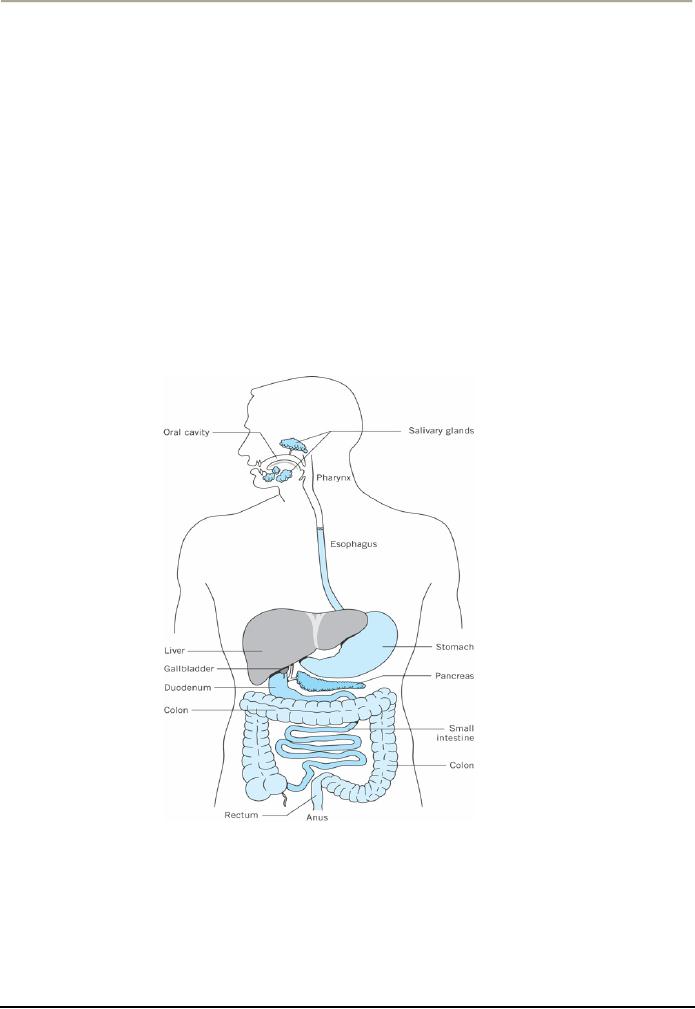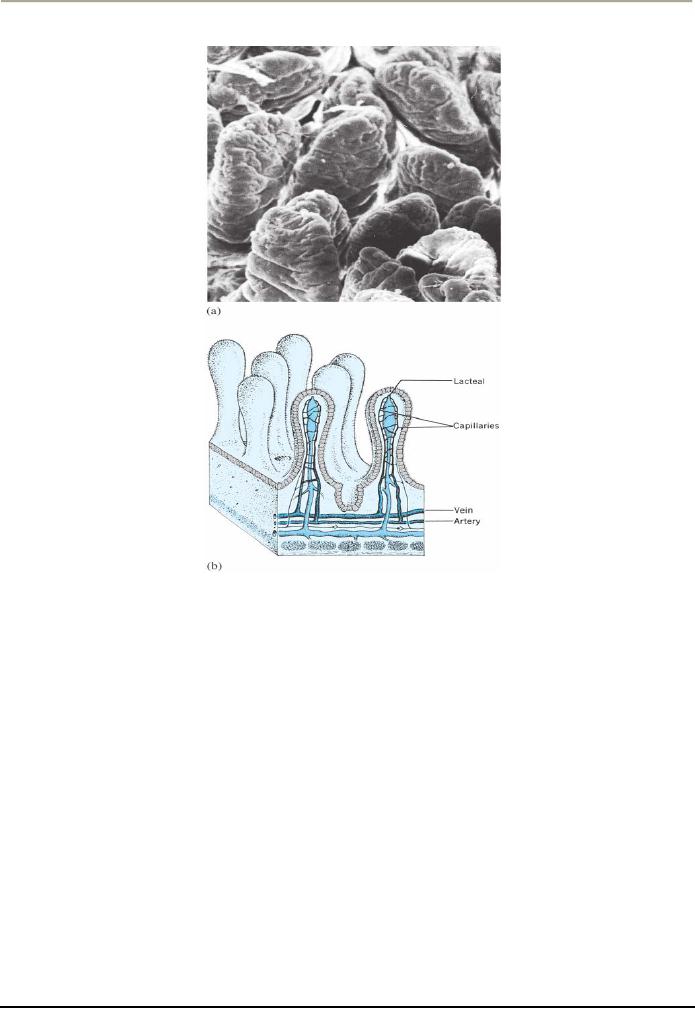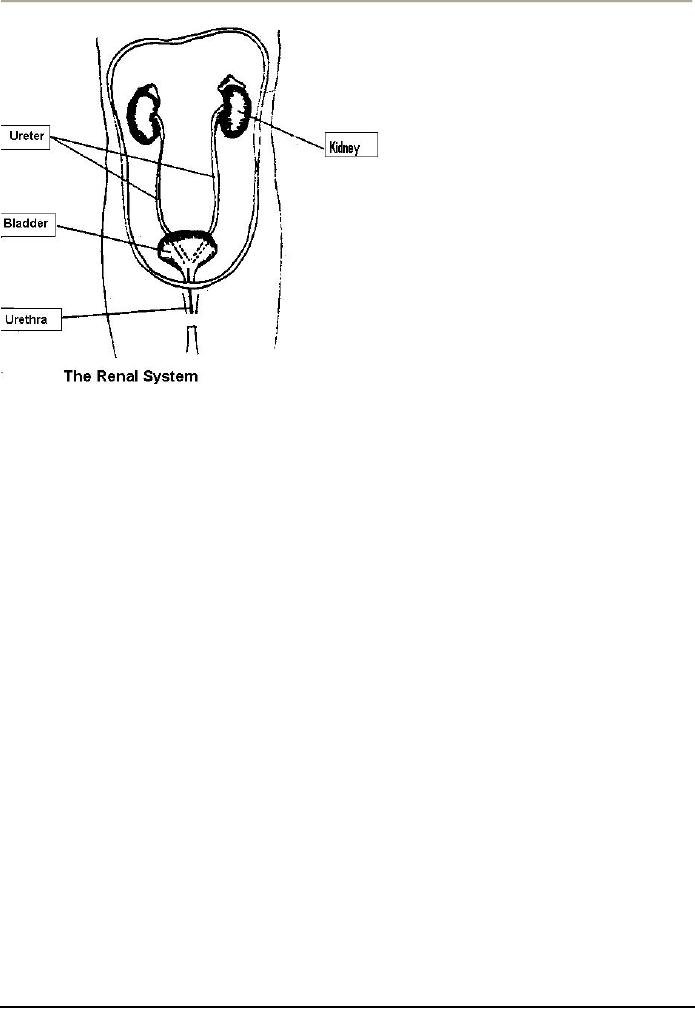 |

Health
Psychology PSY408
VU
LESSON
09
DIGESTIVE
AND RENAL SYSTEMS
THE
DIGESTIVE SYSTEM
Whether
we eat an apple, drink some
milk, or swallow a pill, our
bodies respond in the same
general Way.
The
digestive system breaks down
what we have ingested, converts
much of it to chemicals the body
can
use,
and excretes the rest. The
chemicals the body uses are
absorbed into the bloodstream,
which transports
them
to all of our body cells.
Chemical nutrients in the foods we eat
provide energy to fuel our
activity,
body
growth, and repair.
Food's
Journey through Digestive
Organs
Think
of the digestive system as a long
hose-- about 20 feet long--with
stations along the way.
The
journey
of food through this hose
begins in the mouth and ends
at the rectum. These digestive
organs and
the
major organs in between are
shown in the diagram.
Digesting
Food
How
does this system break down
food? One way is mechanical: for
example, we grind food up
when we
chew
it. Another way is chemical:
by the action of enzymes, substances that
act as catalysts in speeding
up
chemical
reactions in cells. How do
enzymes work? You can see the effect of
an enzyme by doing the
following
experiment. Place a bit of liver in
some hydrogen peroxide and watch what
happens:
40

Health
Psychology PSY408
VU
An
enzyme in liver called
catalase
causes
the peroxide to decompose, frothing as
oxygen is given off as a
gas.
This is the same reaction you see
when you use peroxide to disinfect a
wound.
In
most cases, the names for
enzymes end in the letters
-ase, and
the remainder of each name
reflects the
substance
on which it acts. The
following list gives some
examples:
·
Carbohydrase acts on
carbohydrates.
·
Lactase acts on lactose
(milk).
·
Phosphatase acts on phosphate
compounds.
·
Sucrase acts on sucrose
(sugar).
As
food is broken down into
smaller and smaller units in the
digestive tract, water
molecules become
attached
to these units. When food is in the
mouth, there is more
digestive action going on than
just
chewing.
Saliva moistens food and
contains an enzyme that
starts the process of breaking down
starches.
The
salivary glands release
saliva in response to commands
from the brainstem, which
responds primarily to
sensory
information from taste buds.
Simply seeing, smelling, or
even thinking about food can
produce
neural
impulses that cause the
mouth to water.
The
journey of food advances to the
esophagus, a tube that is normally
flattened when food is not
passing
through
it. The esophagus pushes the
food down to the stomach by wavelike
muscle contractions called
peristalsis. By the time
food enters the esophagus, the
stomach has already begun
digestive activities by
releasing
small amounts of gastric
juice even before food
reaches it. Tasting,
smelling, seeing, or
thinking
about
food can initiate this
process. Once food reaches
the stomach, this organ amasses
large amounts of
gastric
juices, including hydrochloric
acid and pepsin, an enzyme
that breaks down proteins.
The stomach
also
produces a sticky mucus
substance to protect its
lining from the highly
acidic gastric
juices.
The
muscular stomach walls
produce a churning motion--that we
are generally not aware
of--which mixes
the
food particles with the
gastric juices. This mixing
continues for 3 or 4 hours,
producing a semi-
liquid
mixture.
Peristalsis in the stomach then
moves this mixture on, a
little at a time, to the initial section
of the
small
intestine called the duodenum.
Important
digestive processes occur in the
small intestine. First, the highly acidic
food mixture becomes
chemically
alkaline as a result of substances added
from the pancreas, gallbladder, and wall
of the small
intestine.
This is important because the
linings of the small intestine and
remainder of the digestive tract
are
not
protected from high acidity, as the
stomach is. Second, enzymes
secreted by the pancreas into
the
duodenum
break down carbohydrates, proteins,
and fats further. Third,
absorption increases. Because
the
stomach
lining can absorb only a
few substances, such as alcohol
and aspirin, most materials
we ingest are
absorbed
into the bloodstream through the
lining of the small intestine. If alcohol is
consumed along with
fatty
foods, very little alcohol is absorbed
until it reaches the small intestine. By
the time food is ready to be
absorbed
through the intestine wall, nutrients have
been broken down into
molecules--carbohydrates are
broken
down into simple sugars,
fats into glycerol and fatty
acids, and proteins into amino
acids.
How
does Absorption Occur?
The
inside of the small intestine is made of
a membrane that will allow
molecules to pass through.
To
increase
the absorbing surface, the intestine wall
has many folds that contain
projections, as pictured in the
diagram.
41

Health
Psychology PSY408
VU
Each
of the many thousands of projections
contains a network of structures
that will accept the
molecules
and
transport them away to other parts of the
body. These structures include
tiny blood vessels
called
capillaries
and a
tube called a lacteal.
Capillaries
absorb amino acids, simple
sugars, and water; they also
absorb some fatty acids,
vitamins, and
minerals.
Lacteals accept glycerol and the
remaining fatty acids and
vitamins.
The
remaining food material continues
its journey to the large intestine,
most of which is called the
colon.
Absorption,
mainly of water, continues in the first
half of the colon, and the remaining
material is
transported
on. Bacterial action converts the
material into feces, which
eventually reach the rectum,
where
they
are stored until defecation
occurs.
Disorders
of the Digestive
System
Judging
from the many media
advertisements for stomach
and "irregularity" remedies, it
seems that people
have
a good deal of trouble with
their digestive processes. We
will consider a few digestive
problems. One
disorder
of the digestive system is peptic
ulcers.
42

Health
Psychology PSY408
VU
Peptic
Ulcers are
open sores in the lining of
the
stomach or intestine, usually in
the
duodenum.
These sores appear to result
from
excess
gastric juices chronically eroding
the
lining
when there is little or no
food in the
stomach,
but bacterial infection can
play a
role,
too. Abdominal pain is the
chief
symptom
of the disorder. Although the
victims
of ulcers are mostly adults,
the
disorder
also occurs in children,
particularly
boys.
People who experience high
levels of
stress
seem to be more susceptible to
ulcers
than
people who do not.
Hepatitis
is a
class of several viral
diseases in
which
the liver becomes inflamed
and unable
to
function well. The first
symptoms often are
like
those of flu. But the
symptoms persist,
and
jaundice, a yellowing of the skin,
generally
follows.
Hepatitis A appears to be
transmitted
through
contaminated food, water, and
utensils. Hepatitis B and C infections
occur through sexual
contact,
transfusion
of infected blood, and sharing of
contaminated needles by drug addicts,
but the modes of
transmission
may be broader. Some forms of hepatitis
can lead to permanent liver
damage.
Cirrhosis
is another
disease of the liver. In this disease,
liver cells die off and
are replaced by
nonfunctional
fibrous
scar tissue. The scar
tissue is permanent, and when it
becomes extensive, the livers normal
functions
are
greatly impaired. As we will see later, the
liver is not only important
in the digestive process; it
also
cleanses
and regulates the composition of the
blood. Cirrhosis can result
from several causes,
including
hepatitis
infection and, particularly, alcohol
abuse (AMA, 1989).
Cancer
may
occur in any part of the
digestive tract, especially in the
colon and rectum. People
over 40 years
of
age have a higher prevalence
for cancers of the digestive tract than
do younger individuals. Early
detection
for many of these cancers is
possible and greatly improves the
person's chances of
recovery.
THE
RENAL SYSTEM
Overview
The
renal system--consisting of the kidneys,
ureters, urinary bladder, and
urethra--is also critically
important
in metabolism. The kidneys
are chiefly responsible for
the regulation of the bodily fluids;
their
principal
function is to produce urine. The ureters
contain smooth muscle tissue that
contracts, causing
peristaltic
waves to move urine to the bladder, a
muscular bag that acts as a
reservoir for urine. The
urethra
then
conducts urine from the bladder
out of the body.
Urine
contains surplus water,
surplus electrolytes; waste products
from the metabolism of food,
and surplus
acids
or alkalis. By carrying these products
out of the body, it main- tabs
water balance, electrolyte
balance,
and
blood pH. Of the electrolytes,
sodium and potassium are the
most important because they
are involved
in
the normal chemical reactions of the
body, muscular contractions,
and the conduction of nerve
impulses.
Thus,
an important function of the kidneys is
to maintain an adequate balance of sodium
and potassium
ions.
In the case of certain diseases, the
urine will also contain abnormal
amounts of some
constituents;
therefore,
urinalysis offers important diagnostic
clues to many disorders. For
example, an excess of
glucose
43

Health
Psychology PSY408
VU
may
indicate diabetes, an excess of red
blood cells may indicate a
kidney disorder, and so on.
This is one of
the
reasons why a medical
checkup often includes a
urinalysis.
As
noted, one of the chief functions of the
kidneys is to control the water
balance in the body. For
example,
on
a hot day when a person has
been active and has
perspired profusely, relatively little
urine will be
produced
so that the body may retain
more water. This is because
much water has already
been lost through
the
skin. On the other hand, on a cold
day when a person is relatively inactive
and a good deal of liquid
has
been
consumed, urine output will
be higher so as to prevent
over-hydration.
To
summarize, then, the urinary system
regulates bodily fluids by
removing surplus water,
surplus
electrolytes,
and the waste products
generated by the metabolism of
food.
Disorders
of the Renal
System
The
renal system is vulnerable to a number of
disorders. Among the most
common are urinary
tract
infections,
to which women are
especially vulnerable and which
can result in considerable pain,
especially
upon
urination. If untreated, they can
lead to more serious
infection.
AGN
(Acute Glomerular Nephritis) is a
disease that results from an
antigen-antibody reaction in which
the
inner tissues of the kidneys
become markedly inflamed. These
inflammatory reactions can
cause total or
partial
blockage in the kidneys. In severe
cases, total renal shutdown
occurs. Acute glomerular nephritis
is
usually
caused by a kind of streptococcus
infection.
Another
common cause of acute renal shutdown is
tubular
necrosis,
which involves destruction of the
epithelial
cells in the tubules of the kidneys.
Poisons that destroy the
tubular epithelial cells or
severe
circulatory
shock are most common causes
of tubular necrosis.
Kidney
Failure is a
severe disorder because the inability to
produce an adequate amount of urine
will cause
the
waste products of metabolism as well as
surplus inorganic salts and
water to be retained in the body.
An
artificial
kidney, a kidney transplant, or kidney
dialysis may be required in order to
rid the body of its
wastes.
Although
these technologies can
cleanse the blood to remove the
excess salts, water, and
metabolites, they
are
highly stressful medical
procedures. Kidney transplants
carry many health risks, and
kidney dialysis can
be
extremely uncomfortable for patients.
Consequently, health psychologists have
been involved in
addressing
the problems of the kidney
patient.
44
Table of Contents:
- INTRODUCTION TO HEALTH PSYCHOLOGY:Health and Wellness Defined
- INTRODUCTION TO HEALTH PSYCHOLOGY:Early Cultures, The Middle Ages
- INTRODUCTION TO HEALTH PSYCHOLOGY:Psychosomatic Medicine
- INTRODUCTION TO HEALTH PSYCHOLOGY:The Background to Biomedical Model
- INTRODUCTION TO HEALTH PSYCHOLOGY:THE LIFE-SPAN PERSPECTIVE
- HEALTH RELATED CAREERS:Nurses and Physician Assistants, Physical Therapists
- THE FUNCTION OF NERVOUS SYSTEM:Prologue, The Central Nervous System
- THE FUNCTION OF NERVOUS SYSTEM AND ENDOCRINE GLANDS:Other Glands
- DIGESTIVE AND RENAL SYSTEMS:THE DIGESTIVE SYSTEM, Digesting Food
- THE RESPIRATORY SYSTEM:The Heart and Blood Vessels, Blood Pressure
- BLOOD COMPOSITION:Formed Elements, Plasma, THE IMMUNE SYSTEM
- SOLDIERS OF THE IMMUNE SYSTEM:Less-Than-Optimal Defenses
- THE PHENOMENON OF STRESS:Experiencing Stress in our Lives, Primary Appraisal
- FACTORS THAT LEAD TO STRESSFUL APPRAISALS:Dimensions of Stress
- PSYCHOSOCIAL ASPECTS OF STRESS:Cognition and Stress, Emotions and Stress
- SOURCES OF STRESS:Sources in the Family, An Addition to the Family
- MEASURING STRESS:Environmental Stress, Physiological Arousal
- PSYCHOSOCIAL FACTORS THAT CAN MODIFY THE IMPACT OF STRESS ON HEALTH
- HOW STRESS AFFECTS HEALTH:Stress, Behavior and Illness, Psychoneuroimmunology
- COPING WITH STRESS:Prologue, Functions of Coping, Distancing
- REDUCING THE POTENTIAL FOR STRESS:Enhancing Social Support
- STRESS MANAGEMENT:Medication, Behavioral and Cognitive Methods
- THE PHENOMENON OF PAIN ITS NATURE AND TYPES:Perceiving Pain
- THE PHYSIOLOGY OF PAIN PERCEPTION:Phantom Limb Pain, Learning and Pain
- ASSESSING PAIN:Self-Report Methods, Behavioral Assessment Approaches
- DEALING WITH PAIN:Acute Clinical Pain, Chronic Clinical Pain
- ADJUSTING TO CHRONIC ILLNESSES:Shock, Encounter, Retreat
- THE COPING PROCESS IN PATIENTS OF CHRONIC ILLNESS:Asthma
- IMPACT OF DIFFERENT CHRONIC CONDITIONS:Psychosocial Factors in Epilepsy